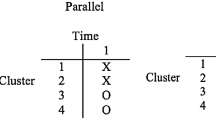Abstract
It is generally difficult or even impossible to obtain a closed-form randomization-based true design effect formula for a nonlinear estimator under a complex sample design. A model that captures different salient features of the sample design is often used to approximate the randomization-based true design effect. Our simulation results show that the usual model-based design effect for the sample mean could significantly differ from the randomization-based true design effect for different replications of the finite population, even when different replicates of the finite population are generated by the same model used to derive the model-based design effect formula. We propose a new model-assisted design effect formula obtained from an appropriate model-based design effect formula when we replace the model intra-cluster correlation by an ANOVA “estimator” if observations for all units of the finite population were available. For one-stage cluster sampling with equal cluster size, we examine the accuracy of the new model-assisted design effect formula analytically and by a Monte carlo simulation. This new model-assisted design effect tracks the true randomization-based design effect much better than the corresponding model-based design effect formulae and the approximation to the true randomization-based design effect proposed by Kish (1965). The main advantage of the new model-assisted design effect is that it can be readily extended to more complex estimators and/or complex designs where the Kish’s approximation is unavailable. Our proposed model-assisted design effect is generally much closer to the randomization-based design effect formula than the corresponding model-based design effect, even when model used to obtain the model-based design effect holds for the finite population.
Access this chapter
Tax calculation will be finalised at checkout
Purchases are for personal use only
Similar content being viewed by others
References
European Social Survey. (2011). Round 6 specification for participating countries. London: Centre for Comparative Social Surveys, City University London.
Gabler, S., Häder, S., & Lahiri, P. (1999). A model based justification of Kish’s formula for design effects for weighting and clustering. Survey Methodology, 25(1), 105–106.
Ghosh, M., & Lahiri, P. (1987). Robust empirical bayes estimation of means from stratified samples. Journal of the American Statistical Association, 82(400), 1153–1162.
Häder, S., Gabler, S., Laaksonen, S. & Lynn, P. (2003). ESS 2002/2003: Technical Report, ESS, chapter The Sample. http://www.europeansocialsurvey.org/index.php?option=com_docman&task=doc_download&gid=199&itemid=80
Kalton, G. (1983). Introduction to survey sampling. Thousand Oaks.
Kish, L. (1965). Survey sampling. Wiley.
Lohr, S. (1999). Sampling: Design and analysis. Duxbury Press.
Lynn, P., & Gabler, S. (2005). Approximations to b* in the prediction of design effects due to clustering. Survey Methodology, 31(2).
Rao, J., & Scott, A. (1981). The analysis of categorical data from complex surveys: chi-square tests for goodness-of-fit and independence in two-way tables. Journal of the American Statistical Association, 76, 221–230.
Skinner, C. (1989). Analysis of complex surveys (pp. 23–58). Wiley (chapter 2).
Skinner, C., Holt, D. & Smith, T. (1989). Analysis of complex surveys. Wiley.
Valliant, R., Dorfman, A. H. & Royall, R. M. (2000). Finite population sampling and inference. Wiley.
Acknowledgements
The authors thank an anonymous referee for a few constructive suggestions that led to improvement of an earlier version of the article. The research of the third author was supported in part by the National Science Foundation Grant Number SES-1534413.
Author information
Authors and Affiliations
Corresponding author
Editor information
Editors and Affiliations
Rights and permissions
Copyright information
© 2018 Springer Nature Singapore Pte Ltd.
About this paper
Cite this paper
Gabler, S., Ganninger, M., Lahiri, P. (2018). A New Approximation to the True Randomization-Based Design Effect. In: Chattopadhyay, A., Chattopadhyay, G. (eds) Statistics and its Applications. PJICAS 2016. Springer Proceedings in Mathematics & Statistics, vol 244. Springer, Singapore. https://doi.org/10.1007/978-981-13-1223-6_10
Download citation
DOI: https://doi.org/10.1007/978-981-13-1223-6_10
Published:
Publisher Name: Springer, Singapore
Print ISBN: 978-981-13-1222-9
Online ISBN: 978-981-13-1223-6
eBook Packages: Mathematics and StatisticsMathematics and Statistics (R0)




